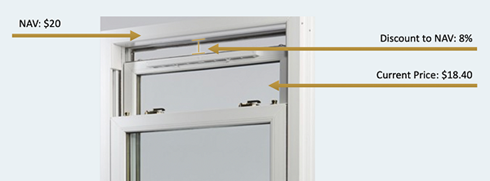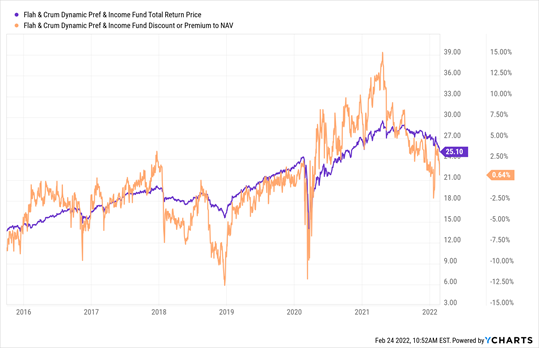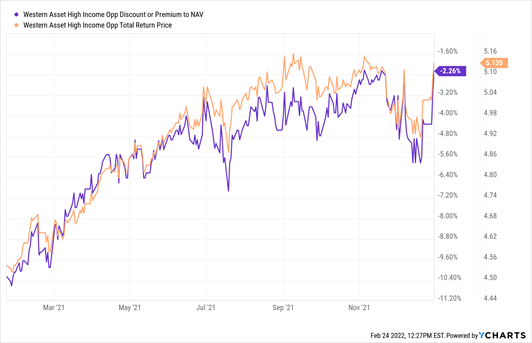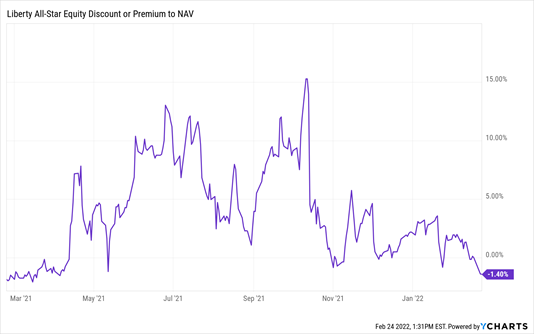I’m about to reveal my very best strategy for pocketing 20%+ upside (and 7.8%+ dividends) from high-yielding closed-end funds (CEFs).
It’s a “rinse and repeat” move that can help you grab the biggest gains from these potent income investments, lock in those wins, then sidestep the pullbacks. (I’ll also show you two ridiculously cheap CEFs throwing off massive yields up to 11.4%.)
It’s the perfect time to put this strategy in play because the Ukraine mess, and the broader market dumpster fire, have set us up with some sweet deals in CEFs.
The One (and Only) Predictor of CEF Upside
Besides massive dividends, CEFs stand out because it’s easy to tell if they’re truly oversold and ready to gap higher.
How? Through a number called the discount to NAV, which is another way of saying a CEF is trading below what the stocks, bonds, REITs or whatever investments it holds are worth on the open market.
These discounts are only available with CEFs, and they couldn’t be easier to spot. Any CEF screener will tell you the discount to NAV, or you can get it straight from the fund company’s website.
So what’s our plan? Simple! We’ll look for discounts that are wider than usual, then buy—and ride the price higher as the fund’s “discount window” closes. We’ll collect our 7%+ dividend the whole time … then clock out when our discount returns to “normal” levels!
The Power of the Disappearing Discount
Here’s what we’re looking for with a “window closing”: an 8% discount to NAV, for example, means a $20 fund (to pick a round number) would be trading for just $18.40. As the window “shuts,” the price will rise. Even if NAV is merely flat, this means we enjoy price upside in addition to our dividend payments!

To show you how an evaporating discount can hand you a strong return, consider the Flaherty & Crumrine Dynamic Preferred and Income Fund (DFP), a core holding in my Contrarian Income Report high-yield investing service.
The fund buys preferred shares—wonderful hybrids that offer aspects of both stocks and bonds. They can trade on an exchange, like any common stock, but they trade around a par value and dole out a set regular payment, like a bond. They’re known for their high dividends, which give DFP its rich 7.5% yield.
Thanks to their low volatility and high yields, preferreds make a great cornerstone for any investor’s portfolio, so they’re good investments to buy and tuck away for the long haul. That’s why we made DFP one of our earliest buys when I launched CIR, picking it up in October 2015, when it traded at a 7.5% discount to NAV.
Since then, it’s handed us an 83% total return! The discount? It’s been slowly whittled away (in the usual two-steps-forward, one-step-back fashion) and is almost completely gone now, which is why we’re sitting on that sweet gain:
DFP’s Discount Disappears, CIR Members Profit

Now that we’ve nailed down how CEFs’ discounts boost our profits, let’s zero in on two other CEFs—a bond fund and an equity fund—whose discounts make them perfect targets for our strategy.
CEF Pick No. 1: A Contrarian Play on Rising Rates (with a 7.8% Yield)
On the corporate-bond side of things, we’ve got plenty of CEFs offering 7%+ dividends and trading at attractive discounts now. That gives you an excellent entry point if you don’t see the yield on the 10-year Treasury rising too far from here.
There are good reasons why it may not, including the big-picture view: for 40 years, rates on the “long bond” have trended lower and lower. Is this the kind of megatrend we want to bet against?
The 40-Year Downtrend in Long Rates

I don’t think so. Besides, what will happen on the other side of these Fed rate hikes? Probably a recession in 2023. Which means that long rates will decline again as the economy slows. At that point, a 7.8%+ yield will look pretty darned good!
Enter the Western Asset High Income Opportunity Fund (HIO), which holds 233 corporate bonds with an average term to maturity of just under seven years.
It’s a perfect example of how we can ride a closing CEF discount to big gains (and dividends). Right now, HIO trades at a 9.7% discount to NAV, the best deal we’ve seen since January 2021.
How did folks who bought back then make out? Just fine! If you’d bought then, when HIO’s discount stood around 10%, and stepped out on December 31, when that discount narrowed to just 2% (near levels unseen since 2013), you’d have bagged a sweet 13% return in 11 months.
Moreover, your return would’ve come with very little volatility, because more than half of it was in cash, thanks to HIO’s dividend.
HIO’s Discount Disappears, Inflating Its Return

Fast-forward to today and we’ve got another chance to work this “rinse and repeat” trade, as HIO trades near a 10% discount again:
HIO’s “Buy Signal” Reappears

If you’re unwilling to bet against the long-term downtrend in “long bond” yields (a wise approach, if you ask me), this is a great time to buy HIO, as its discount sets us up for an extra price bounce.
CEF Pick No. 2: An 11.4% Dividend Available at Last March’s Prices
For stocks, consider the Liberty All-Star Equity Fund (USA). As the ticker suggests, it holds top US blue chip stocks like Amazon.com (AMZN), Alphabet (GOOGL), Visa (V) and Microsoft (MSFT).
USA yields an outsized 11.4% and pays dividends quarterly, with a stated goal of paying out 10% of its NAV per year. The crowd often overlooks USA for two main reasons:
- Its dividend flexes with its NAV, which is actually a good move because the fund isn’t risking a surprise dividend cut (which can send its share price tumbling), and …
- It often trades at a premium, and when it does trade at a discount, as it does now, the markdown tends to be small: as I write, USA’s discount is 1.4%.
To be sure, 1.4% doesn’t sound like much of a deal, but this shows why, when it comes to CEF discounts, you need to go beyond the headline number and look at the history. When you do, you see that USA is cheaper than it’s been in a year:
USA’s Discount Window Reopens

As with HIO, the power of the closing discount is what you want to watch here: if you’d bought a year back, the last time USA traded at today’s levels, you’d have bagged a 29% total return by the time its premium peaked at 15% in October!
And also like HIO, USA is giving us another “rinse and repeat” discount opportunity to jump on today.
Breakthrough Portfolio Pays You 7%+ Dividends Every Single Month
USA’s flexible dividend is great because it tends to result in higher yields than most other CEFs pay, and it frees you from the risk of a surprise dividend cut (and resulting share-price plunge), too!
But many folks need a much steadier income stream, which is what CEFs like HIO and DFP provide. Not only do they pay you steady dividends north of 7%, but they pay you every single month, too—right in line with your bills!
They’re just the start: my “7% Monthly Dividend Portfolio” gives you MANY more monthly payers to bolster your income stream. They come from across the economy AND they trade at deep discounts, too!
This unique portfolio offers just the kind of high (monthly) income and upside you need in today’s panicky markets. I want to give you all the details now: Click here and I’ll give you everything you need to know about my “7% Monthly Dividend Portfolio,” including the specific names and tickers to buy today!
Don’t wait. The sooner you make your move, the sooner you can kickstart your own 7%+ monthly income stream.

Recent Comments